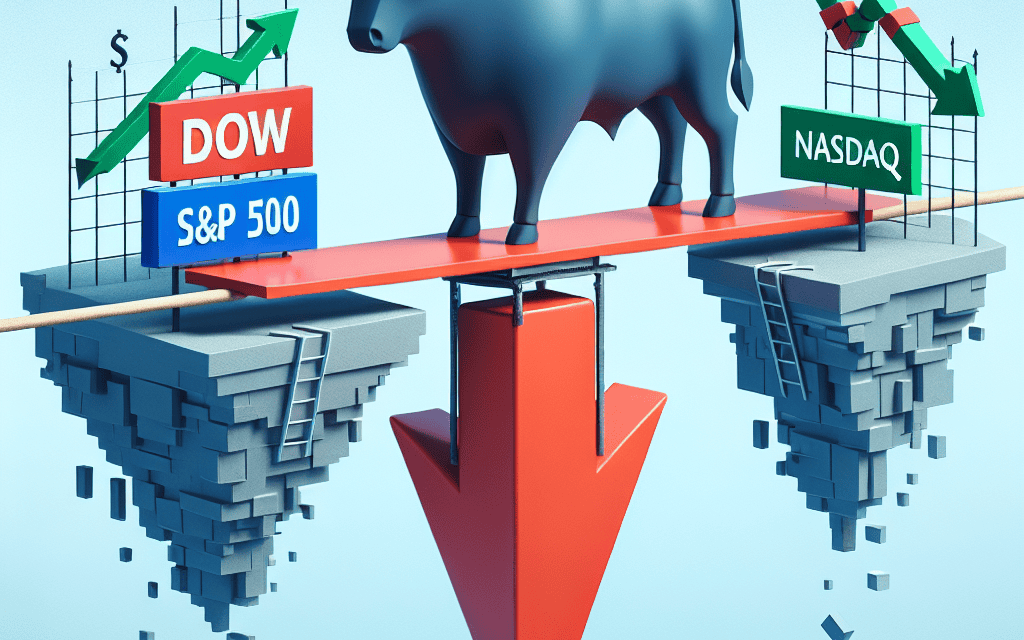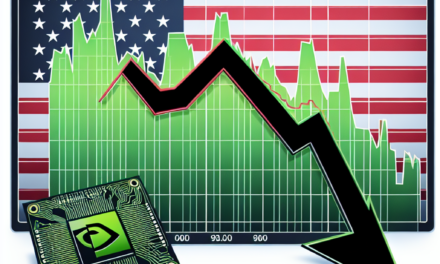“Market Jitters: Dow and S&P 500 Slide, Nasdaq Wavers as Earnings Flood In”
Introduction
In the latest stock market developments, the Dow Jones Industrial Average and the S&P 500 experienced a dip, reflecting investor caution amid a flurry of corporate earnings reports. Meanwhile, the Nasdaq Composite displayed signs of volatility, struggling to find stable ground as technology and growth stocks faced mixed reactions from the market. This period of earnings announcements has brought a wave of financial disclosures from major companies, influencing market sentiment and driving fluctuations across key indices. As investors digest these earnings results, the market remains on edge, balancing optimism for corporate performance against broader economic concerns.
Impact Of Earnings Reports On Major Indices
The recent fluctuations in the stock market have drawn significant attention, particularly as the Dow Jones Industrial Average and the S&P 500 experienced notable dips, while the Nasdaq Composite displayed signs of instability. These movements are largely attributed to the ongoing earnings season, which has introduced a wave of financial reports from major corporations. As investors digest these earnings reports, the impact on major indices becomes increasingly evident, underscoring the intricate relationship between corporate performance and market dynamics.
Earnings reports serve as a critical barometer for investors, offering insights into a company’s financial health and future prospects. As such, they play a pivotal role in shaping market sentiment. This earnings season has been particularly eventful, with a mix of positive surprises and disappointing results. Companies that have exceeded expectations have provided a boost to investor confidence, while those that have fallen short have contributed to market volatility. Consequently, the Dow and S&P 500 have experienced downward pressure, reflecting the mixed outcomes of these corporate disclosures.
The Dow Jones Industrial Average, a key indicator of market performance, has been particularly sensitive to earnings reports from its constituent companies. As some of the blue-chip stocks reported weaker-than-expected earnings, the index faced downward pressure. This decline highlights the interconnectedness of individual corporate performances and broader market trends. Similarly, the S&P 500, which encompasses a broader range of companies, has also been affected by the earnings season. The index’s dip can be attributed to the underperformance of certain sectors, such as technology and consumer goods, which have faced challenges in meeting market expectations.
Meanwhile, the Nasdaq Composite, known for its heavy concentration of technology stocks, has exhibited signs of instability. The tech sector, often seen as a bellwether for innovation and growth, has faced a mixed bag of earnings results. While some tech giants have reported robust earnings, others have struggled with supply chain disruptions and changing consumer behaviors. This has led to a lack of clear direction for the Nasdaq, as investors weigh the potential for future growth against current challenges.
In addition to individual earnings reports, broader economic factors have also played a role in shaping market movements. Inflation concerns, interest rate fluctuations, and geopolitical tensions continue to influence investor sentiment. These factors, combined with the earnings season, have created a complex landscape for market participants to navigate. As a result, the interplay between corporate earnings and macroeconomic conditions has become a focal point for investors seeking to understand the current market environment.
Looking ahead, the impact of earnings reports on major indices is likely to persist as more companies release their financial results. Investors will continue to scrutinize these reports for indications of future performance and potential risks. Moreover, the ongoing analysis of economic indicators will remain crucial in assessing the broader market outlook. As the earnings season progresses, the ability of companies to adapt to changing conditions and deliver strong financial results will be key in determining the trajectory of major indices.
In conclusion, the recent dips in the Dow and S&P 500, along with the unsteady performance of the Nasdaq, underscore the significant impact of earnings reports on major indices. As investors navigate this complex landscape, the interplay between corporate performance and broader economic factors will continue to shape market dynamics. Understanding these relationships is essential for making informed investment decisions in an ever-evolving financial environment.
Analyzing The Dow’s Recent Performance
In recent weeks, the stock market has experienced a series of fluctuations, with the Dow Jones Industrial Average and the S&P 500 both experiencing notable dips. Meanwhile, the Nasdaq Composite has shown signs of instability amid a surge in corporate earnings reports. This period of volatility can be attributed to a confluence of factors, including investor reactions to earnings announcements, macroeconomic indicators, and geopolitical developments. As we delve into the Dow’s recent performance, it is essential to consider these elements and their implications for the broader market.
The Dow Jones Industrial Average, a key barometer of the U.S. stock market, has faced downward pressure as investors digest a mixed bag of earnings results from major corporations. While some companies have reported robust earnings that exceeded expectations, others have fallen short, leading to a cautious sentiment among investors. This cautiousness is further exacerbated by concerns over inflationary pressures and potential interest rate hikes by the Federal Reserve. As a result, the Dow has experienced a series of declines, reflecting the market’s uncertainty and the balancing act investors must perform between optimism and caution.
Transitioning to the S&P 500, this index has similarly faced challenges, with its performance closely mirroring that of the Dow. The S&P 500, which encompasses a broader range of companies, has been influenced by sector-specific dynamics. For instance, the technology sector, which has been a significant driver of market gains in recent years, has shown signs of slowing momentum. This deceleration is partly due to supply chain disruptions and regulatory pressures, which have weighed on investor sentiment. Consequently, the S&P 500 has experienced a dip, highlighting the interconnectedness of various sectors and their collective impact on the index’s performance.
Meanwhile, the Nasdaq Composite has exhibited a degree of instability, oscillating between gains and losses. This volatility can be attributed to the tech-heavy nature of the index, which makes it particularly sensitive to shifts in investor sentiment towards technology stocks. As earnings season progresses, the Nasdaq has been subject to rapid changes in response to the performance of major tech companies. While some have delivered impressive results, others have faced challenges, leading to an uneven performance across the index. This unsteadiness underscores the importance of earnings reports in shaping market dynamics and influencing investor behavior.
In addition to earnings reports, macroeconomic factors have played a crucial role in shaping the current market landscape. Inflation remains a key concern, with rising prices affecting consumer spending and corporate profitability. The Federal Reserve’s monetary policy decisions are closely watched, as any indication of interest rate adjustments could have significant implications for the stock market. Furthermore, geopolitical tensions, such as trade disputes and international conflicts, add another layer of complexity to the market environment, contributing to the overall sense of uncertainty.
In conclusion, the recent performance of the Dow Jones Industrial Average, the S&P 500, and the Nasdaq Composite reflects a complex interplay of factors, including corporate earnings, macroeconomic indicators, and geopolitical developments. As investors navigate this challenging landscape, they must remain vigilant and adaptable, balancing optimism with caution. The coming weeks will likely provide further insights into the market’s trajectory, as additional earnings reports and economic data are released. Ultimately, understanding these dynamics is essential for making informed investment decisions in an ever-evolving market environment.
S&P 500: Factors Behind The Recent Dip
The recent dip in the S&P 500 has captured the attention of investors and analysts alike, as the index, which serves as a barometer for the overall health of the U.S. stock market, has shown signs of volatility. This downturn can be attributed to a confluence of factors, each playing a significant role in shaping the current market landscape. As we delve into these elements, it becomes evident that the interplay between macroeconomic indicators, corporate earnings, and investor sentiment is crucial in understanding the recent movements in the S&P 500.
To begin with, macroeconomic indicators have been a primary driver of the recent dip. Inflationary pressures continue to loom large, with the Consumer Price Index (CPI) reflecting persistent increases in the cost of goods and services. This has led to heightened concerns about the Federal Reserve’s monetary policy trajectory. Investors are wary of potential interest rate hikes, which could dampen economic growth and, consequently, corporate profitability. The anticipation of tighter monetary policy has, therefore, contributed to the cautious sentiment surrounding the S&P 500.
In addition to macroeconomic factors, corporate earnings have played a pivotal role in influencing the index’s performance. The earnings season has been a mixed bag, with some companies exceeding expectations while others have fallen short. Notably, sectors such as technology and consumer discretionary have faced headwinds, as supply chain disruptions and rising input costs have eroded profit margins. These challenges have been reflected in the earnings reports of several high-profile companies, leading to downward revisions in their stock prices and, by extension, exerting pressure on the S&P 500.
Moreover, geopolitical tensions have added another layer of complexity to the market dynamics. Ongoing conflicts and trade disputes have created an environment of uncertainty, prompting investors to reassess their risk exposure. The global interconnectedness of markets means that geopolitical developments can have far-reaching implications, influencing investor sentiment and market performance. As a result, the S&P 500 has experienced fluctuations as market participants react to the evolving geopolitical landscape.
Furthermore, investor sentiment has been a critical factor in the recent dip. The stock market is inherently forward-looking, and investor perceptions about future economic conditions can significantly impact market movements. Currently, there is a palpable sense of caution among investors, driven by concerns over inflation, interest rates, and geopolitical risks. This cautious sentiment has manifested in increased market volatility, as investors grapple with the uncertainty surrounding the economic outlook.
In light of these factors, it is essential to recognize that the recent dip in the S&P 500 is not an isolated event but rather a reflection of broader market dynamics. The interplay between macroeconomic indicators, corporate earnings, geopolitical tensions, and investor sentiment underscores the complexity of the current market environment. As investors navigate these challenges, it is crucial to maintain a long-term perspective and consider the underlying fundamentals that drive market performance.
In conclusion, the recent dip in the S&P 500 can be attributed to a combination of macroeconomic pressures, mixed corporate earnings, geopolitical uncertainties, and cautious investor sentiment. While these factors have contributed to the index’s volatility, they also highlight the importance of a comprehensive understanding of the market landscape. As the situation continues to evolve, investors will need to remain vigilant and adaptable, ready to respond to new developments that may influence the trajectory of the S&P 500.
Nasdaq’s Volatility In The Current Market Climate

In the current market climate, the Nasdaq has exhibited notable volatility, reflecting the broader uncertainties and fluctuations within the financial landscape. As investors navigate through a period marked by a surge in corporate earnings reports, the Nasdaq’s performance has been particularly unsteady. This instability is largely attributed to the mixed signals emanating from various sectors, which have left market participants grappling with both optimism and caution.
The recent dip in the Dow Jones Industrial Average and the S&P 500 has further underscored the complexities facing the stock market. While these indices have experienced declines, the Nasdaq’s erratic behavior highlights the unique challenges and opportunities present within the technology and growth-oriented sectors. The earnings season has brought a wave of financial disclosures from major corporations, each contributing to the market’s overall sentiment. As companies report their quarterly results, investors are keenly analyzing these figures to gauge the health and future prospects of the economy.
Amid this earnings surge, the technology sector, which heavily influences the Nasdaq, has been at the forefront of investor attention. Companies within this sector have delivered a mixed bag of results, with some exceeding expectations while others have fallen short. This divergence in performance has contributed to the Nasdaq’s volatility, as investors reassess their positions based on the latest data. Moreover, the rapid pace of technological innovation and the ongoing digital transformation across industries continue to add layers of complexity to market predictions.
In addition to earnings reports, external factors such as geopolitical tensions, inflationary pressures, and shifts in monetary policy have also played a significant role in shaping the Nasdaq’s trajectory. These elements have created an environment of uncertainty, prompting investors to remain vigilant and adaptable. The Federal Reserve’s stance on interest rates, for instance, remains a critical point of focus, as any adjustments could have far-reaching implications for the stock market, particularly for growth stocks that are sensitive to changes in borrowing costs.
Furthermore, the global economic landscape is undergoing significant transformations, with supply chain disruptions and energy market fluctuations adding to the market’s unpredictability. These challenges have prompted companies to reassess their strategies and adapt to the evolving conditions, which in turn influences investor sentiment and market dynamics. As a result, the Nasdaq’s performance is not only a reflection of individual corporate earnings but also a barometer of broader economic trends and investor confidence.
Despite the current volatility, there are opportunities for investors who are willing to navigate the complexities of the market. Diversification and a focus on long-term growth potential remain key strategies for mitigating risks and capitalizing on potential gains. As the earnings season progresses, investors will continue to scrutinize corporate performance and macroeconomic indicators to inform their investment decisions.
In conclusion, the Nasdaq’s volatility in the current market climate is emblematic of the broader uncertainties facing the stock market. As earnings reports continue to pour in, and external factors exert their influence, investors must remain astute and adaptable. By understanding the interplay between corporate performance, economic conditions, and market sentiment, investors can better position themselves to navigate the challenges and opportunities that lie ahead.
Key Earnings Surprises And Their Market Implications
In recent weeks, the stock market has experienced a series of fluctuations, with the Dow Jones Industrial Average and the S&P 500 both experiencing dips, while the Nasdaq remains unsteady. This volatility can be attributed to a surge in earnings reports, which have delivered a mix of surprises that have left investors reassessing their strategies. As companies across various sectors release their quarterly results, the market is reacting to both positive and negative earnings surprises, each carrying significant implications for future market movements.
To begin with, several high-profile companies have reported earnings that exceeded analysts’ expectations, providing a boost to investor sentiment. For instance, a leading technology firm recently announced a substantial increase in its quarterly profits, driven by strong demand for its innovative products and services. This unexpected performance has not only bolstered the company’s stock price but also instilled confidence in the broader tech sector, which has been a key driver of market growth in recent years. Consequently, investors are now more optimistic about the potential for continued expansion in this sector, despite the overall market’s unsteady performance.
Conversely, some companies have reported earnings that fell short of expectations, leading to a decline in their stock prices and contributing to the overall market dip. A prominent example is a major retail chain that revealed weaker-than-anticipated sales figures, attributed to supply chain disruptions and changing consumer preferences. This disappointing performance has raised concerns about the retail sector’s ability to navigate ongoing challenges, prompting investors to reevaluate their positions in this space. As a result, the market has seen increased volatility, with investors seeking to balance their portfolios in light of these mixed earnings results.
Moreover, the financial sector has also played a significant role in shaping recent market dynamics. Several banks have reported robust earnings, driven by higher interest rates and increased lending activity. These positive results have provided a degree of stability to the market, as investors view the financial sector as a bellwether for economic health. However, concerns about potential regulatory changes and geopolitical tensions continue to weigh on investor sentiment, adding another layer of complexity to the market’s current state.
In addition to sector-specific developments, broader economic indicators are influencing market reactions to earnings reports. Inflationary pressures and interest rate hikes remain at the forefront of investors’ minds, as they assess the potential impact on corporate profitability and consumer spending. Companies that have demonstrated resilience in the face of these challenges are being rewarded with increased investor interest, while those that have struggled are facing heightened scrutiny.
As the earnings season progresses, it is clear that the market is in a state of flux, with each new report contributing to the evolving landscape. Investors are closely monitoring these developments, seeking to identify trends and opportunities that may arise from the current environment. While the Dow and S&P 500 have experienced dips and the Nasdaq remains unsteady, the market’s response to earnings surprises underscores the importance of adaptability and strategic thinking in navigating these uncertain times.
In conclusion, the recent surge in earnings reports has had a profound impact on the stock market, with both positive and negative surprises shaping investor sentiment and market movements. As companies continue to release their results, the implications for various sectors and the broader economy will become increasingly apparent. Investors must remain vigilant and responsive to these developments, as they seek to navigate the complexities of the current market landscape.
Sector-Wise Breakdown Of Stock Market Movements
In the latest stock market developments, the Dow Jones Industrial Average and the S&P 500 experienced a dip, while the Nasdaq Composite displayed signs of instability amid a surge in corporate earnings reports. This fluctuation in the stock market can be attributed to a variety of sector-specific movements, each contributing uniquely to the overall market dynamics. As investors navigate these changes, understanding the sector-wise breakdown of stock market movements becomes crucial.
To begin with, the technology sector, which has been a significant driver of market performance in recent years, showed mixed results. While some tech giants reported robust earnings, exceeding market expectations, others faced challenges that led to a decline in their stock prices. For instance, companies heavily reliant on consumer electronics experienced a slowdown in sales, attributed to supply chain disruptions and changing consumer preferences. This uneven performance within the tech sector contributed to the Nasdaq’s unsteady behavior, as investors weighed the potential for future growth against current uncertainties.
Transitioning to the financial sector, banks and financial institutions reported strong earnings, buoyed by rising interest rates and increased lending activity. The Federal Reserve’s monetary policy, aimed at curbing inflation, has led to higher interest rates, which in turn have benefited banks by widening their net interest margins. However, concerns about potential loan defaults and economic slowdown have tempered investor enthusiasm, resulting in a cautious approach towards financial stocks. This cautious sentiment was reflected in the overall performance of the Dow and S&P 500, as financial stocks constitute a significant portion of these indices.
Meanwhile, the energy sector has been experiencing a resurgence, driven by rising oil prices and increased demand for energy products. Geopolitical tensions and production cuts by major oil-producing nations have contributed to the upward trajectory of oil prices, benefiting energy companies. As a result, energy stocks have provided a counterbalance to the declines seen in other sectors, offering some support to the broader market indices. Nevertheless, the volatility in oil prices remains a concern for investors, as it introduces an element of unpredictability to the sector’s future performance.
In contrast, the consumer goods sector faced headwinds, with inflationary pressures impacting consumer spending patterns. Rising costs of raw materials and transportation have led to increased prices for consumer goods, which in turn have affected sales volumes. Companies in this sector are grappling with the challenge of maintaining profit margins while ensuring affordability for consumers. This sector’s struggles have contributed to the downward pressure on the S&P 500, as consumer goods companies represent a substantial component of the index.
Furthermore, the healthcare sector has shown resilience, with pharmaceutical companies reporting strong earnings driven by demand for innovative treatments and vaccines. The ongoing focus on healthcare advancements and the aging population continue to provide growth opportunities for this sector. However, regulatory challenges and pricing pressures remain potential obstacles that could impact future performance.
In summary, the recent movements in the stock market can be attributed to a complex interplay of sector-specific factors. While the technology and consumer goods sectors faced challenges, the financial, energy, and healthcare sectors provided some stability. As investors assess these developments, a sector-wise analysis offers valuable insights into the underlying trends shaping the market. By understanding these dynamics, investors can make informed decisions, navigating the uncertainties and opportunities that lie ahead in the ever-evolving stock market landscape.
Investor Strategies Amidst Market Fluctuations
In the ever-evolving landscape of financial markets, investors are constantly seeking strategies to navigate the fluctuations that characterize stock indices. Recently, the Dow Jones Industrial Average and the S&P 500 have experienced notable dips, while the Nasdaq Composite remains unsteady amidst a surge in corporate earnings reports. This environment presents both challenges and opportunities for investors aiming to optimize their portfolios.
To begin with, the recent downturn in the Dow and S&P 500 can be attributed to a confluence of factors, including geopolitical tensions, inflationary pressures, and shifts in monetary policy. These elements have collectively contributed to a climate of uncertainty, prompting investors to reassess their positions. In such times, diversification remains a cornerstone strategy. By spreading investments across various sectors and asset classes, investors can mitigate risks associated with market volatility. For instance, while technology stocks may be experiencing turbulence, sectors such as healthcare or consumer staples might offer more stability, providing a buffer against broader market declines.
Moreover, the current earnings season has introduced an additional layer of complexity. As companies report their quarterly results, investors are keenly analyzing performance metrics to gauge future prospects. While some firms have exceeded expectations, others have fallen short, leading to mixed reactions in the market. This underscores the importance of a nuanced approach to stock selection. Investors are advised to delve beyond headline figures, examining factors such as revenue growth, profit margins, and forward guidance. By doing so, they can identify companies with robust fundamentals that are well-positioned to weather economic headwinds.
In addition to fundamental analysis, technical analysis can serve as a valuable tool in navigating market fluctuations. By studying price patterns and trading volumes, investors can gain insights into potential entry and exit points. This approach can be particularly useful in volatile markets, where timing is crucial. For instance, identifying support and resistance levels can help investors make informed decisions about when to buy or sell, thereby enhancing their ability to capitalize on short-term market movements.
Furthermore, the role of macroeconomic indicators cannot be overlooked. Economic data releases, such as employment figures, inflation rates, and GDP growth, have a profound impact on market sentiment. Investors who stay informed about these indicators can better anticipate market trends and adjust their strategies accordingly. For example, rising inflation may prompt central banks to tighten monetary policy, which could affect interest rate-sensitive sectors. By understanding these dynamics, investors can position themselves to benefit from shifts in the economic landscape.
In conclusion, the current state of the stock market, characterized by dips in the Dow and S&P 500 and an unsteady Nasdaq, calls for a strategic approach to investing. By embracing diversification, conducting thorough fundamental and technical analyses, and staying attuned to macroeconomic indicators, investors can navigate the complexities of the market with greater confidence. While challenges persist, the potential for growth remains, offering astute investors the opportunity to achieve their financial objectives amidst the ebb and flow of market fluctuations. As always, maintaining a long-term perspective and exercising patience will be key in weathering the inevitable ups and downs of the financial markets.
Q&A
1. **Question:** What recent trend has been observed in the Dow Jones Industrial Average?
– **Answer:** The Dow Jones Industrial Average has recently dipped.
2. **Question:** How has the S&P 500 performed in the latest stock market update?
– **Answer:** The S&P 500 has also experienced a dip.
3. **Question:** What is the current state of the Nasdaq in the stock market?
– **Answer:** The Nasdaq is currently unsteady.
4. **Question:** What is contributing to the current stock market conditions?
– **Answer:** An earnings surge is contributing to the current stock market conditions.
5. **Question:** Are there any specific sectors or companies driving the earnings surge?
– **Answer:** The question does not specify, but typically technology and financial sectors often drive earnings surges.
6. **Question:** How might investors react to the current stock market trends?
– **Answer:** Investors might react with caution or adjust their portfolios in response to the dips and unsteadiness.
7. **Question:** What could be a potential outcome if the current trends continue?
– **Answer:** If the current trends continue, there could be increased market volatility and potential shifts in investment strategies.
Conclusion
The recent stock market update indicates a mixed performance among major indices, with the Dow Jones Industrial Average and the S&P 500 experiencing declines, while the Nasdaq remains volatile. This movement comes amid a surge in corporate earnings reports, which have introduced uncertainty and varied investor reactions. The dip in the Dow and S&P 500 suggests cautious sentiment, possibly driven by concerns over economic indicators or specific sector performances. Meanwhile, the Nasdaq’s unsteady behavior reflects the tech-heavy index’s sensitivity to earnings results and market speculation. Overall, the market’s current state underscores the complex interplay between earnings announcements and broader economic factors, highlighting the need for investors to remain vigilant and adaptable in their strategies.




